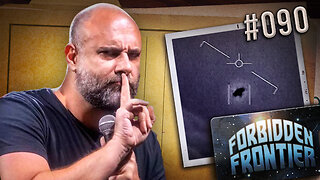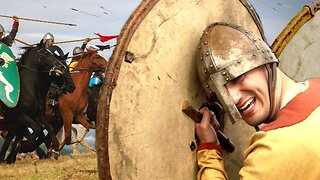Premium Only Content

Entertaining Bufflehead ducks swim in Lake Ontario
Bufflehead ducks swim buoyantly, dive easily, and take flight by running a short distance on the surface. They fly low over the water and higher over the land. To dive, Bufflehead ducks compress their plumage to squeeze out air, then give a slight forward leap and plunge powerfully downward. They hold their wings tightly against their bodies underwater and use only their feet to propel themselves. At the end of a dive, they may bob to the surface like a cork. Throughout the day they alternate between bouts of feeding, swimming alertly, preening, and sleeping. Bufflehead are seldom seen on dry land: females walk only when they lead their ducklings from the nest to the water or when they’re forced to switch ponds with their ducklings. Males court females by flying over them, skiing to a stop on the water with their crests raised, and bobbing their heads. During the breeding season, territorial birds attack intruders by flying or swimming underwater at them and thrashing at them with their wings. When a pair of Buffleheads intrudes into a nearby territory, the male that owns the territory often chases the intruding female, and her mate follows them in hot pursuit. Males leave their mates during incubation in order to molt, but return to the same mate multiple years in a row (one of the few duck species in which this is true.)
Bufflehead dive for aquatic invertebrates, crustaceans, and mollusks. They typically swallow their food while still underwater. Dives last on average about 12 seconds and rarely more than 25 seconds, typically staying on the surface another 12 seconds or so before diving again. Bufflehead forage in open, shallow water over sparse submerged vegetation or over mudflats that would be exposed at low tide. On freshwater they mostly eat damselfly and dragonfly larvae, midge larvae, water boatmen, mayfly larvae, caddisfly larvae, large zooplankton such as amphipods, and snails and clams in winter. They eat some plant matter in fall and winter, mainly seeds of pondweeds and bulrushes. In saltwater, Bufflehead eat shrimp, crabs, amphipods, isopods, snails, mussels, herring eggs, sculpins, and ratfishes. Downy ducklings sometimes dabble at the surface rather than diving.
Bufflehead ducks are funny and entertaining to watch. As soon as they hear a strange sound they instantly disappear!
-
 1:20:04
1:20:04
Tim Pool
4 days agoGame of Money
108K11 -
 2:21:11
2:21:11
Nerdrotic
15 hours ago $31.95 earnedDown the Rabbit Hole with Kurt Metzger | Forbidden Frontier #090
145K25 -
 2:41:13
2:41:13
vivafrei
20 hours agoEp. 251: Bogus Social Security Payments? DOGE Lawsduit W's! Maddow Defamation! & MORE! Viva & Barnes
262K290 -
 1:19:23
1:19:23
Josh Pate's College Football Show
13 hours ago $4.78 earnedBig Ten Program Rankings | What Is College Football? | Clemson Rage| Stadiums I Haven’t Experienced
72.7K1 -
 13:22:09
13:22:09
Vigilant News Network
19 hours agoBombshell Study Reveals Where the COVID Vaccine Deaths Are Hiding | Media Blackout
116K58 -
 1:17:59
1:17:59
Sarah Westall
14 hours agoDOGE: Crime & Hysteria bringing the Critics & the Fearful - Plus new CDC/Ukraine Crime w/ Dr Fleming
99.7K13 -
 45:39
45:39
Survive History
20 hours ago $10.98 earnedCould You Survive in the Shield Wall at the Battle of Hastings?
88.9K7 -
 1:50:28
1:50:28
TheDozenPodcast
19 hours agoViolence, Abuse, Jail, Reform: Michael Maisey
119K6 -
 23:01
23:01
Mrgunsngear
1 day ago $6.81 earnedWolfpack Armory AW15 MK5 AR-15 Review 🇺🇸
101K13 -
 25:59
25:59
TampaAerialMedia
1 day ago $4.58 earnedUpdate ANNA MARIA ISLAND 2025
65.4K4